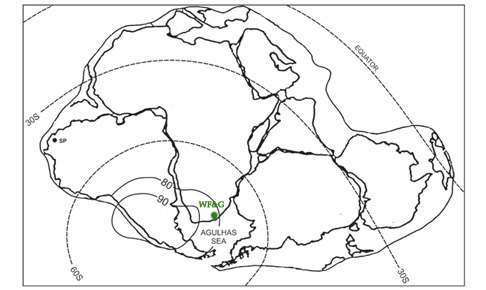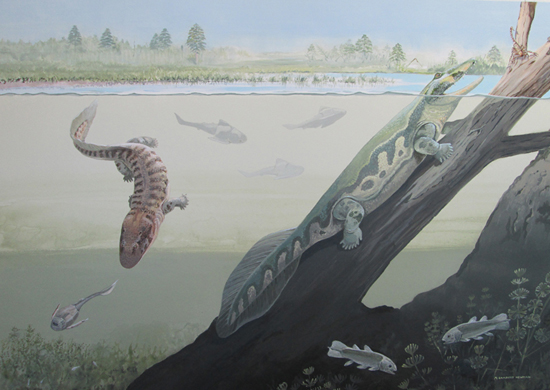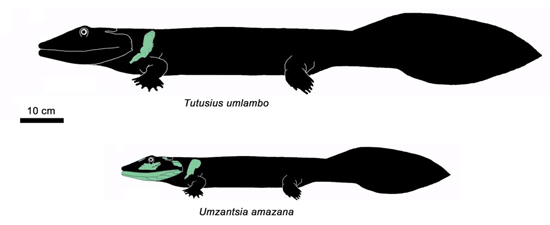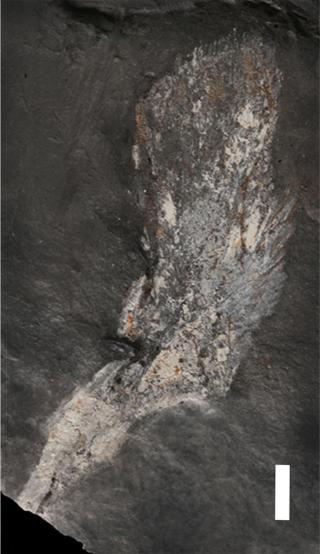South African Fossils Re-write History of Life on Land
Some of the First Land Vertebrates Lived in Antarctica
The fossilised remains of two newly described Late Devonian tetrapods have helped to shed new light on the evolution of land vertebrates. Since most of the known Devonian tetrapod fossils are associated with equatorial palaeoenvironments, it had been thought that the first animals with back bones to adapt to a life on land must have lived in very close to the equator. However, these new specimens lived on the southernmost portion of the giant super-continent Gondwana. These early land pioneers of 360 million years ago were living within the Antarctic circle.
A Life Reconstruction of the Two Newly Described Tetrapod Species from the Waterloo Farm Site
Picture credit: Maggie Newman
Devonian Tetrapods
The evolution of the first land animals from fish during the Devonian geological period is regarded as a key event in the history of life on Earth. Newly described fossils from the Waterloo Farm locality near Grahamstown (Easter Cape Province, South Africa), are challenging current perceptions about where in the world the first land vertebrates evolved.
Lead author of the scientific paper, published in the journal “Science”, Dr Robert Gess (Albany Museum, Grahamstown), explained:
“Whereas all previously found Devonian tetrapods came from localities which were in tropical regions during the Devonian, these specimens lived within the Antarctic circle.”
The First African Devonian Tetrapods
The researchers, including co-author Professor Per Ahlberg (Uppsala University, Sweden), name two new species Tutusius umlambo and Umzantsia amazana from fragmentary bones from a road cutting at the Waterloo Farm site, bones from the shoulder girdle related to these new early tetrapods, are helping palaeontologists to gain a better understanding of the development of the shoulder girdle from a fish to that of a tetrapod, adapted to walking around on land.
Tutusius and Umzantsia, are Africa’s earliest known four-legged vertebrates by a remarkable 70 million years. The approximately one-metre-long Tutusius umlambo (named in honour of Archbishop Emeritus Desmond Tutu) and the somewhat smaller Umzantsia amazana are both incomplete.
Tutusius is represented by a single bone from the shoulder girdle, whereas Umzantsia is known from a greater number of bones, but they both appear similar to previously known Devonian tetrapods. Alive, they would have resembled a cross between a salamander and a fish, with an amphibian-like head, stubby legs with numerous fingers and a tail that was reminiscent of a tadpole’s.
Scale Drawings of Tutusius and the Smaller Umzantsia
Picture credit: University of Witwatersrand
The Waterloo Farm site, where the fossils were discovered, is a road cutting first exposed two years ago after controlled rock-cutting explosions by the South African National Roads Agency (SANRAL). This very important fossil site is along the N2 highway between Grahamstown and the Fish River. The construction crew exposed dark, grey mudstones of the Witpoort Formation. The strata represent sedimentary deposits laid down in a brackish, tidal river estuary. The rocks preserve numerous fossils, including animals and plants.
To read Everything Dinosaur’s article about the fortuitous discovery of this important fossil site: Roadway Leads to Devonian Deposit.
Antarctic Tetrapods
The discovery of these fossils is extremely significant not only for what was found, but where they were found. Devonian tetrapod fossils are found in widely scattered localities. However, if the continents are mapped back to their Devonian positions, it emerges that all previous finds are from rocks deposited in the palaeotropics, between 30 degrees north and south of the equator.
Almost all these rare and important fossils come from Laurasia, a super-continent that later fragmented into North America, Europe and Greenland. Umzantsia and Tutusius have certainly bucked this trend. Gondwana, the much larger, southern super-continent (made up of present -day South America, Australia, Madagascar, Australia, India and Africa), has hitherto yielded virtually no evidence of Devonian tetrapods.
Footprints ascribed to early tetrapods have been discovered in Australia and an isolated jawbone was found in New South Wales. When this jawbone fossil was first studied, scientists thought it represented the jaw of a lobe-finned fish. However, subsequent research led to the conclusion that this single bone came from a primitive tetrapod. The species Metaxygnathus denticulus was erected.
During the later stages of the Devonian, this part of Australia was associated with the northern Gondwana. It would have been located in the tropics. As a result, it was assumed that movement of vertebrates from water onto land (terrestrialisation) also occurred in the tropics. Attempts to understand the causes of these major macroevolutionary steps therefore focused on conditions prevalent in tropical water bodies.
The fossil Cleithrum of T. umlambo
Picture credit: University of Witwatersrand
Challenging Current Perceptions and Assumptions About Tetrapod Evolution
The two early tetrapods named from Waterloo Farm fossils, also come from Gondwana, but from an environment associated with the southernmost part of the super-continent. Waterloo Farm was approximately seventy degrees south, within the Antarctic circle. Many plant and insect fossils recovered from the road side indicate that the climate was much milder than the Antarctic circle today, but it would still have been cold and during the long winter season, this region would have experienced many months when the sun did not appear above the horizon. These amphibians would have had to endure long periods of darkness.
The Location of the Waterloo Farm Site in the Late Devonian

Picture credit: University of Witwatersrand with additional annotation by Everything Dinosaur
The researchers conclude that these fossils change our understanding of the distribution of Devonian tetrapods. We now know that tetrapods occurred throughout the world by the Late Devonian and that their evolution and terrestrialisation could realistically have occurred anywhere.
Visit Everything Dinosaur: Everything Dinosaur.




